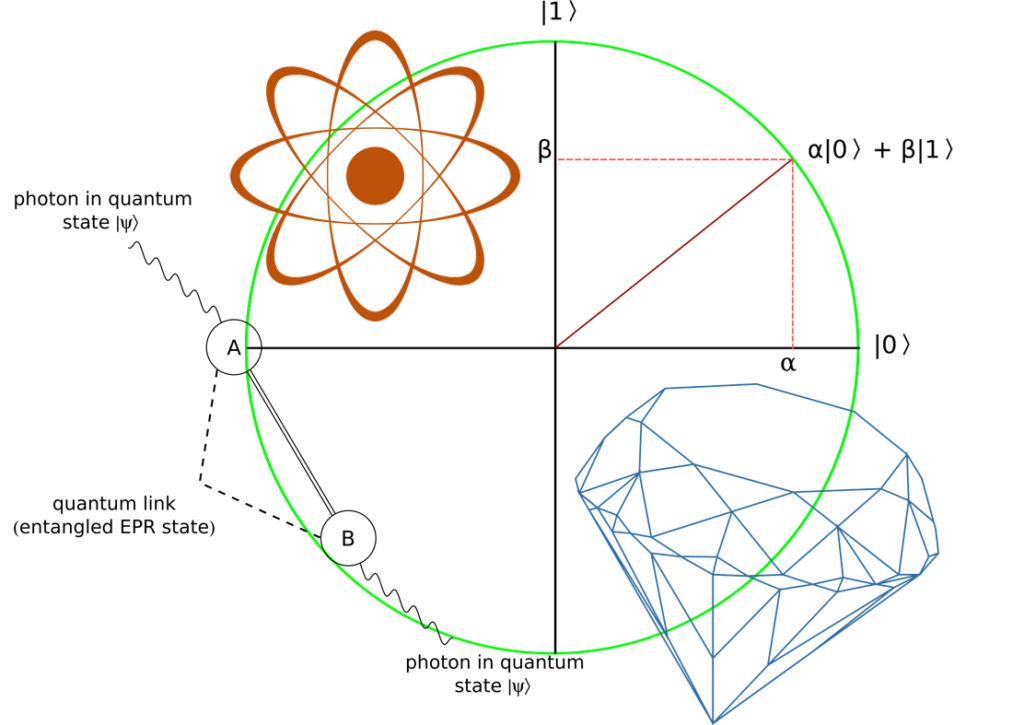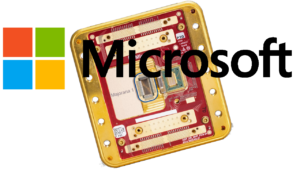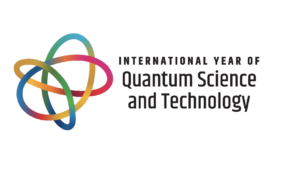Nearly every week some researcher around the world announces another breakthrough inching the world closer to developing generalized quantum computing capabilities. As a result, Chris Brandt reports, “A lot of experts and scientists predict that 2017 could be the beginning of quantum computers.”[1] In addition to interest in quantum computing by large companies such as Google, Microsoft, and IBM, Brandt reports a number of academic institutions are trying to develop quantum computing capabilities. “Christopher Monroe, a physicist at the University of Maryland in College Park,” Brandt writes, “observed that scientists and engineers are going beyond the realm of experiment towards the actual building of these super computers. Monroe is also the co-founder of the startup IonQ which is also set to build their own quantum computer. Monroe and his startup aren’t alone. Yale University physicist Robert Schoelkopf is also racing to build a quantum computer at Yale with his startup called Quantum Circuits while Chad Rigetti, a former IBM applied physicist, who founded Rigetti said they are reaching crucial technical milestones as well.”
Quantum computing is based in the weird and wonderful world of quantum physics, where a quantum bit (i.e., a qubit) can simultaneously be both a “1” and a “0”. Until recently, quantum computing was primarily a theoretical concept; but, the Canadian company D-Wave claims to have built a quantum computer that specializes in solving optimization problems. Mike White writes, “If you can get your head around it, then there’s enough free information and resources available for anyone to have a go at making their quantum computer. And now, blueprints have been made available that may help those willing to try.”[2] The blueprints were released by Winfried Hensinger, a quantum computing researcher from the University of Sussex (UK). He says, “For many years, people said that it was completely impossible to construct an actual quantum computer. With our work, we have not only shown that it can be done, but now we are delivering nuts and bolts construction plan to build an actual large-scale machine.” Hensinger and his team published their blueprint in “an open-access paper in the Science Advances journal. … The design involves multiple trapped ion-based scalable quantum computing modules with an architecture based on long-wavelength radiation quantum gates. Hensinger’s team say modules could be built using silicon microfabrication techniques that are within reach of current technology. A high-threshold surface error correction code can be implemented in the architecture to execute fault-tolerant operations.”[3]
The Importance of Quantum Computing
Even with blueprints, building a quantum computer is going to be neither easy nor cheap. Richard Waters (@RichardWaters) writes, “Most researchers agree that full-scale computers based on quantum mechanics, theoretically making them massively more powerful than existing machines, are still years away. … The current state of quantum technology is still equivalent only to the level that digital computing had reached in the 1940s.”[4] Yet there is an international race to develop one. Why? As Jelor Gallego observes, “Classical computing tech is nearing its limit. Many have predicted the end of Moore’s law, and they are looking at the next step in the computing world: quantum computers.”[5] Even if the end of Moore’s law were not in sight, classical computers are incapable of performing calculations necessary to tackle some of the universe’s hardest problems because it would take them billions of years to solve. Quantum computers could theoretically take on these challenges and solve them in a reasonable amount of time. If you are interested in learning more about quantum computing, click on this link to watch a 20-minute explanation provide by Harvard professor Amir Yacob. In the video, Yacob explains why things such as encryption are going to be impacted by the introduction of quantum computers. He notes, for example, that 1,000 qubits equal the computing power of 1,000,000,000 classical bits. And Waters notes, “A full-scale quantum computer … is estimated to require at least 500,000-1m qubits.” With that kind of computing power, today’s encryption would be child’s play to break; leaving all sorts of systems vulnerable to hacking. Companies like IBM are interested in quantum computing because it would make data mining much faster. And, Yacob notes, quantum computers could also be used to simulate how nature behaves at the quantum level. Others problems ripe for solving by quantum computers include: complex networks; environmental modeling; image processing; materials design; and drug design.
The current challenge is to create and stabilize enough qubits to make a quantum computer useful. Yacob notes that in 2010 scientists were routinely able to create a single qubit; by 2010, that number had increased to 10 qubits. You can see that to reach the 500K to 1M qubit stage is going to take some time. Qubits are notoriously fragile. That’s why most attempts to create them require researchers to work at temperatures near absolute zero and to shield qubits from interference by outside particles. Some of the breakthroughs discussed below address the challenge of creating more stable qubits. The staff at the Wall Street Pit reports, “A way to predict and stabilize quantum system behavior has been discovered. And it’s about to revolutionize the world of quantum computing.”[6] They explain, “If we were to make a survey on what super-ability an individual would like to have, being able to predict the future will probably be among those on top of the list. And for scientists using quantum systems, this would be an extremely useful ability, especially because one of the biggest stumbling blocks they have been trying to get around is knowing when quantum decoherence — the process where quantum systems break down and become too randomized to the point of being useless — will happen. If they only knew how to predict this, quantum technology will easily get the jumpstart it needs to become a reality. Thankfully, the gift of ‘foresight’ is not necessary because University of Sydney quantum physicists headed by Professor Michael J. Biercuk have figured out a way to predict the future of quantum systems. … They found that they can make compensations before … changes take place so they can prevent [a] system from failing. Armed with this information, they were able to successfully prolong the quantum state and extend the usefulness of qubits. According to Professor Biercuk: ‘Our techniques apply to any qubit, built in any technology, including the special superconducting circuits being used by major corporations’. He also adds that, ‘We’re excited to be developing new capabilities that turn quantum systems from novelties into useful technologies. The quantum future is looking better all the time’.”
Some Other Recent Breakthroughs
New Matter Discovered: “Physicists have discovered a new form of matter that breaks the symmetry of time. These crystals have a structure that repeats in time as they are ‘kicked’ periodically, like the way Jell-O jiggles when it is tapped, and researchers say they represent one of the first examples of ‘non-equilibrium matter.’ Researchers have shown that ‘time crystals’ can behave similarly to qubit systems, meaning they could one day be used in quantum computers.”[7]
Groups of Photons on Demand. “Holographic atomic memory, invented and constructed by physicists from the Faculty of Physics at the University of Warsaw, is the first device able to generate single photons on demand in groups of several dozen or more. The device, successfully demonstrated in practice, overcomes one of the fundamental obstacles towards the construction of some type of quantum computer. Completely secure, high-speed quantum communication, or even a model of quantum computer, may be among the possible applications for the new source of single photons recently built at the Faculty of Physics at the University of Warsaw (UW Physics), Poland. An unprecedented feature of this new device is that for the first time it enables the on-demand production of a precisely controlled group of photons, as opposed to just a single one.”[8]
Room Temperature Molecular Magnets. “Molecular magnets are basically molecules that have magnetic capabilities. They’re generally made up of only a few atoms, which makes it possible to compress them together at ultra-high densities. If a hard-disk drive was to use molecular magnets as bits, its capacity can hypothetically be increased up to a thousand times, which means a standard hard-disk will be able to store over 1,000,000 gigabytes of data. Aside from increasing a hard drive’s storage capacity, molecular magnets can supposedly be used in quantum computing too. But there’s a big stumbling block. In theory, a hard disk that’s made up of magnetic molecules will lose all of the data that’s stored in it unless it’s maintained at a temperature no higher than -200 degrees Celsius. … Thanks to a research team led by Professor Stefano Sanvito, Director of the CRANN Institute at Trinity and Investigator in the Science Foundation Ireland-funded centre AMBER, efforts toward achieving that goal finally seem to be paying off. According to a report that came out of Trinity College Dublin, Professor Sanvito, together with Dr. Alessandro Lunghi (of AMBER) and University of Firenze Professor Roberta Sessoli and her team, were able to demonstrate that when molecules are engineered to be as rigid as possible, they become capable of operating at normal room temperature. It is this capability that can make these molecular magnets the stuff that quantum computers are, or will be, made of.”[9]
Diamonds may be a Quantum Computing’s Best Friend. Chris Lee (@exmamaku) asks, “What type of basic technology should be used as the basis for quantum computers?”[10] Diamonds, it turns out, are a likely candidate for use in quantum computers. Lee explains, “One approach, which has been quietly awaiting its next moment, is nitrogen-vacancy centers (NV- centers) in diamond. Although there have been a lot of exciting developments in terms of showing that NV- centers have excellent characteristics for qubits (a unit of quantum information), no one seems to be able to find a practical way to link anything more than a couple of qubits. Those days may be coming to an end, though, according to a recent study in Nature Photonics, the results of which could shift NV- centers off the bench, back onto the playing field. … A diamond is supposed to be pure carbon. Each carbon atom is attached to four other carbon atoms. The structure is very rigid, conducts heat very well, and conducts electricity not at all. In that sense, if a qubit were contained in a diamond crystal, it would be fairly well isolated from the surrounding environment, which is exactly what we need to protect the data stored in each qubit. Diamonds are not pure, though, which is both a blessing and a curse. Their impurities are a blessing because they form the basis for a diamond qubit, and they are a curse because they ruin some of the excellent properties that diamond has.” Karen Hurst reports scientists in Russia are also experimenting with diamonds. “Scientists have developed a way to mass-produce tiny diamond crystals shaped like needles and threads, which may power next generation of quantum computing,” she writes. “Physicists from the Lomonosov Moscow State University in Russia have described structural peculiarities of micrometre-sized diamond crystals in needle and thread-like shapes, and their interrelation with luminescence features and field electron emission efficiency.”[11]
Quantum Computer Memory Cell larger than a Qubit. “Scientists from the Institute of Physics and Technology of the Russian Academy of Sciences and MIPT have let two electrons loose in a system of quantum dots to create a quantum computer memory cell of a higher dimension than a qubit (a quantum bit). In their study published in Scientific Reports, the researchers demonstrate for the first time how quantum walks of several electrons can help to implement quantum computation.”[12]
Entanglement Made Easier. “Researchers from the Tyndall National Institute have devised a method that would make entangling photons easier, and accelerate our journey towards the quantum computing age. … Researchers created quantum dot light-emitting diodes that can produce entangled photons (QDLEDs). The pyramid-shaped quantum dots of the QDLED — as in the same technology behind QDLED TV’s — are electrified using nanotechnology to entangle the photons. It is these pyramidal structures that allow physicists control over the process — something that has been significantly difficult over the years.”[13]
Molecules as Qubits. “A team of researchers from the University of Manchester announced … they had taken a significant step forward in the creation of viable quantum computers. In a study published in the latest edition of the journal Chem, the researchers provided evidence that large molecules made of nickel and chromium could be used as qubits — the quantum computing equivalent of the bits used to store and process information in conventional computers. According to the study, it is possible, at least in theory, to use molecular chemistry to connect these molecules, thereby creating several stable qubits that can then be used to create two-qubit logic gates.”[14]
Summary
All of these breakthroughs help inch the world towards the quantum computing era. Whether that era is years or decades away is unknown; however, for the first time, researchers are certain the goal will eventually be achieved.
Footnotes
[1] Chris Brandt, “The Year 2017 Could Be The Start Of Quantum Computers,” University Herald, 4 January 2017.
[2] Mike White, “Want to Build Your own Quantum Computer? Here is the Blueprint,” TrendinTech, 14 February 2017.
[3] Chris Mellor, “UK prof claims to have first practical blueprint of a quantum computer,” The Register, 13 February 2017.
[4] Richard Waters, “IBM aims to spark revolution in quantum computing,” Financial Times, 6 March 2017.
[5] Jelor Gallego, “Google’s Quantum Computer May be Superior to Conventional Computers by 2018,” Futurism, 2 September 2016.
[6] Staff, “The Breakthrough That Quantum Scientists Have Been Waiting For,” Wall Street Pit, 19 January 2017.
[7] Cheyenne MacDonald, “Scientists create a new form of matter – and say time crystals could lead to a quantum computing revolution,” Daily Mail, 26 January 2017.
[8] University of Warsaw Physics Faculty, “Large groups of photons on demand — an equivalent of photonic ‘integrated circuit’,” EurekAlert!, 8 February 2017.
[9] Staff, “Molecular Magnets Breakthrough Brings Quantum Computers Closer to Reality,” Wall Street Pit, 5 March 2017.
[10] Chris Lee, “Grids of defects make diamonds practical for quantum computing,” Ars Technica, 19 December 2016.
[11] Karen Hurst, “Diamonds might power the next generation of Quantum computing,” Lifeboat Foundation, 2 January 2017.
[12] Moscow Institute of Physics and Technology, “Scientists create a quantum computer memory cell of a higher dimension than a qubit,” Phys.org, 13 December 2016.
[13] Cecille De Jesus, “New Method Could Make Quantum Computers a Reality Sooner Than We Thought,” Futurism, 18 November 2016.
[14] Avaneesh Pandey, “Quantum Computing: Large Molecules Can Be Used To Create Stable Qubit Gates, Manchester University Researchers Say,” International Business Times, 15 November 2016.





